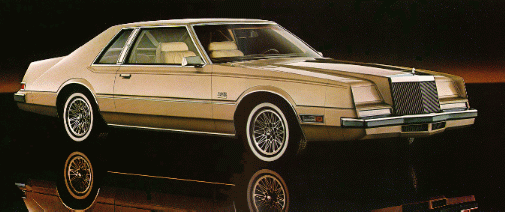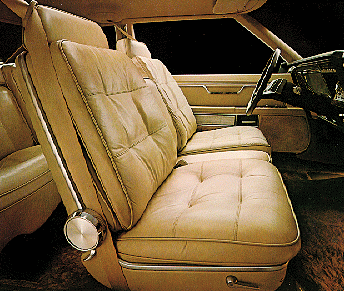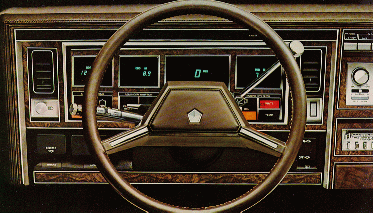It's time for Imperial
 The late 1970's saw Chrysler struggling
not only financially, but with a tarnished image as an auto manufacturer.
Along with the other U.S. auto makers, Chrysler had been trying to down-size
and revamp it's product line to compete with Japanese and other imports.
During the 1970's, all of the large 'prestige' models had been sacrificed
due to higher fuel prices and foreign competition. This had led to the
sacrifice of the Imperial name in 1975 when the last of the big name cars
rolled off the assembly line.
The late 1970's saw Chrysler struggling
not only financially, but with a tarnished image as an auto manufacturer.
Along with the other U.S. auto makers, Chrysler had been trying to down-size
and revamp it's product line to compete with Japanese and other imports.
During the 1970's, all of the large 'prestige' models had been sacrificed
due to higher fuel prices and foreign competition. This had led to the
sacrifice of the Imperial name in 1975 when the last of the big name cars
rolled off the assembly line.
Proposed introduction of a new 'J' body for the Cordoba/Mirada line and
styling efforts for a new luxury coupe were all taking place during
Chrysler's darkest hours as a company. While at the brink of financial
disaster, new management led by former Ford executive Lee Iococca, began
to examine Chrysler's products in order to make decisions about the
future of the company. Iococca had been behind the use of Ford's
Thunderbird car line as a platform for the Lincoln Mark III in 1968. The new
Cordoba body seemed appropriate for a similar transformation into what would
become the 'new' Imperial.

The 1981-83 Imperials were aimed at the top of the personal luxury car
market. These cars tried to combine the best of everything Chrysler had to
offer. They featured technological enhancements and distinctive styling.
Although the '81 Imperial shared it's platform with the Chrysler Cordoba and
Dodge Mirada, very little of the top-side sheet metal was common between the
cars. Imperial shared only it's front fenders and doors with the Cordoba.
All other exterior sheet metal and body components were different. The most
notable difference is evident in the rear quarter panel and deck lid
styling.
Other unique features offered only on these cars included:
- Chrysler's first electronic fuel injection.
- Chrysler's first electronic instrumentation.
- Integrated garage door opener.
- Introduction of Mark Cross leather interiors.
- Standard extended warranty.

Two of Imperial's most notable features involved vehicle electronics.
Inside the car, the typical analog gauges were replaced by a series of
fluorescent displays giving the driver every bit of information that could
be imagined. Unlike many other digital instrument clusters that mimicked
the operation of analog gauges, the Imperial's displays represented
everything numerically. Fuel, economy, elapsed time, date, time, speed, and
odometer were only represented numerically. Chrysler even went as far as
incorporating the transmission quadrant indicator into the electronic
display.

The second piece of high-tech Imperial electronics was out under the
hood, in the form of Chrysler's first electronic fuel injection. Chrysler
had pioneered electronic ignition and computerized engine controls in the
1970's. Imperial's engine was a standard 318 cubic inch V8 with a special
intake manifold and the fuel injection system resting on top. Unlike modern
electronic fuel injection systems that meter fuel based on how long the
injector is held open by electric current, Imperial's system was based on
varying pressure. The system used a typical in-tank fuel pump to provide basic
fuel delivery to the engine. A second "control" pump was used to vary the
rate of fuel delivery to the engine through two pressure controlled injector
valves. The system seemed to be more of an electrified mechanical injection
system than what we would think of today as electronic fuel injection. To
Chrysler's credit, the fuel injection gave the Imperial impressive throttle
response and much better economy than the carburated models. However the
fuel injection system was plagued by reliability problems that led to many
cars being retrofitted with conventional carburated fuel systems by
Chrysler. The fuel injection suffered from the problems of over complexity
and difficulty in diagnosing problems. Chrysler's consistent choice to put
vital electronic components under the hood, where they were subject to
extreme conditions, doubtlessly played a part in the lack of reliability.

Chrysler had projected an annual sales volume of 25,000 units for the
Imperial. The continuing recession hurt the already poor luxury car market
and left the $18,000 Imperial sitting in the showrooms. The first year's
production fell far short of it's goal at only 8113 units. For reasons
which have never been clear, Chrysler brought back the Imperial in 1982 with
a price tag $3,000 higher than the 1981 model. The car was otherwise
unchanged and produced even slower sales for a total of 2717 units.
With a new outlook, and a new pocketbook based on small front wheel drive
'K' cars, Chrysler made plans to eliminate the slow selling 'J' bodied cars.
The Imperial's lesser cousins, Cordoba and Mirada, were no longer fast
sellers and plans were made to stop production after the 1983 model year.
Imperial did make it back for 1983, but after only 1510 units rolled out the
door, Chrysler pulled the plug. This sent the Imperial name back into the
history books for a few more years. The name was briefly resurrected as a
variant of the front wheel drive New Yorker in the 1990's and then fell into
obscurity once more. It is hard to guess if and when the Imperial name will
once again grace the road as a unique top end Chrysler automobile.
 Return to the main page.
Return to the main page.
 The late 1970's saw Chrysler struggling
not only financially, but with a tarnished image as an auto manufacturer.
Along with the other U.S. auto makers, Chrysler had been trying to down-size
and revamp it's product line to compete with Japanese and other imports.
During the 1970's, all of the large 'prestige' models had been sacrificed
due to higher fuel prices and foreign competition. This had led to the
sacrifice of the Imperial name in 1975 when the last of the big name cars
rolled off the assembly line.
The late 1970's saw Chrysler struggling
not only financially, but with a tarnished image as an auto manufacturer.
Along with the other U.S. auto makers, Chrysler had been trying to down-size
and revamp it's product line to compete with Japanese and other imports.
During the 1970's, all of the large 'prestige' models had been sacrificed
due to higher fuel prices and foreign competition. This had led to the
sacrifice of the Imperial name in 1975 when the last of the big name cars
rolled off the assembly line.




 Return to the main page.
Return to the main page.